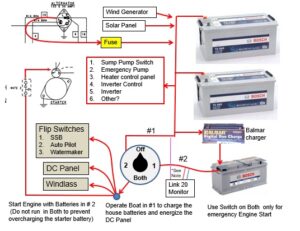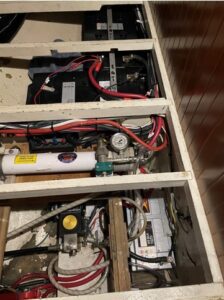Maintenance
Thursday, Jan 20, 2022
Latitude 28o 30’ N
Longitude 16o 12’ W
Varaderos Anaga , Tenerife
Maintenance
I returned to Tenerife a week earlier than the crew out of concern over the batteries. Back in the Fall at least one of those batteries had failed and the others were suspect due to their age. The boat evoked images of the Command Module in the movie Apollo 13 as the electrical system slowly bled to death. At the dock in the Santa Cruz Marina, Kay and I had to run the diesel engine three times a day just to keep the batteries topped off with enough power to restart. Even then the motor would chug for a disconcertingly long time before finally coughing to life.
Fortunately, Lillian was once again conveniently in a port in her time of need. The Varaderos Anaga Boatyard, where she was to spend her next three months, has access to the repair and supply services of the local chandlery Spinnaker.
Unfortunately, chandleries in the Canary Island don’t carry six-volt batteries such as the ones in the Lillian B. The only solution was to reconfigure the entire system with new 12-volt batteries. Back in the US, Johanson Boatworks (i.e., Jonesy) came up with a solution that could use 12-volt batteries and still fit in the space occupied by the old configuration.
For those interested in engineering details, the old system consisted of eight six-volt batteries wired in pairs to boost the voltage to twelve and then these pairs were arranged in parallel to create two equal battery banks which could serve either to start the engine or run the lights and electronics. The new system is to consist of a large “house” battery bank (two Bosch T3 81 12-volt batteries) for running the boat’s various electrical systems and a secondary “starter” battery (Bosch S5 015 12-volt) reserved for starting the engine.
Only the house battery bank is to be connected directly to the boat’s three sources of energy: the engine driven alternator, the wind driven generator, and the solar panel. The charge on the starter battery is then maintained by the house bank using a “smart” trickle charger that only tops off the starter battery when needed and prevents overcharging.

Wiring Diagram for Lillian’s new 12-volt batteries
The corresponding circuit diagram for the new system and corresponding explanation (with Google translation) were sent ahead to Spinnaker back in December, but the e-mail responses from at Spinnaker Chandlery didn’t instill confidence and phone conversations didn’t help either, given the language barrier.
Out of concern, I rebooked my flight to arrive a week earlier than originally planned and showed up at the boat just in time to find that the mechanics were diligently wiring it according to what they thought it should be, not according to what was on the wiring diagram and not including a trickle charger. A week later Lillian was lowered into the water with a brand-new set of batteries that were still not wired according to the diagram, and still lacking a trickle charger, but the work was almost complete and all the key components, most importantly the batteries were on board. She was ready to set sail and the electrical system can be fine-tuned on the way home.

New batteries (and water-maker) under the aft bunk